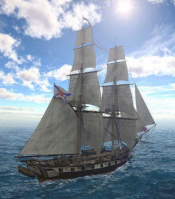
The Presidential Library collections present: 215 years ago Ivan Krusenstern "introduced the fleet to the ocean" and initiated Russian round-the-world voyages
The early XIX century was marked in Russia by the rapid development of navigation. The first Russian round-the-world voyage of I. F. Krusenstern and Y. F. Lisyansky can rightly be called unprecedented in terms of outbrave and generalized after the return of research results. August 7, 2018, the country will celebrate the 215th anniversary of the day when sails were hoisted above the legendary sloops "Nadezhda" and "Neva" and the expedition started to the unknown. In its wake in the next two decades followed no less significant round-the-world voyages of our compatriots. Extensive information about these expeditions will be included in a new large-scale collection of the Presidential Library "Russian Round-the-World Voyages of the First Half of the XIX Century".
The Presidential Library collections contain rare books and documents where the pioneers are honored, whose paths are always the most difficult ones. Krusenstern’s major work "Round-the-World Voyage in 1803, 4, 5 and 1806 on ships "Nadezhda "and" Neva", an electronic copy of which is available on the portal of the Presidential Library, gives the most ample description of the course of the expedition and fell on its participants of dangers and deprivations. The assistant to the chief of the expedition and the commander of the "Neva" was appointed fellow student of the Krusenstern Marine Corps Yury Fedorovich Lisyansky, who happily wrote to him: "... would be very happy to be with you together ...". Detailed recommendations, routes and expectations of seafarers are described in the handwritten document "Instruction of the Main Board of the Russian-American Company to the chief of the first Russian Round-the-World Expedition to Lieutenant-Commander I. F. Krusenstern", available on the Presidential Library portal.
During the expedition aboard both sailboats, nothing happened except the crushing storms that sometimes tore the sails to shreds. "The longer the voyage lasted", - we read in the book "Russian Round-the-World Voyage. From Krusenstern to "Sedov", the poorer the food was. Three times a week they ate corned beef. Sometimes a good supplement to the table were tuna or mackerel. Somehow one of the sailors caught a dolphin 3,5 feet long. Officers bought it to cook to the table ... ".
In such harsh conditions it was necessary not only to survive, but also to provide a trigonometric survey, to make notes in personal diaries of observations, to help taken on board naturalists. Krusenstern was in charge of the entire ship and crew, supervised navigational and astronomical observations, and provided extensive research work. This is reflected an electronic copy of the publication "Admiral I. F. Krusenstern. The first Russian Navigator Around the World". It notes that the participants of the first Russian circumnavigation were set specific commercial goals, but not only they led the waves of brave sailors: "This expedition had the immediate goal of indicating a more convenient way by which Russia could supply its colonies on the North-West coast of America. <...> But this brilliant logistics plan was not the main task of the expedition. The expedition was not managed to show the Russian flag in passing to the whole world and to make several discoveries, it was not like that, Krusenstern wished that his enterprise would set in motion round-the-world Russian voyages; he wanted the Russian fleet to achieve in all respects the right to take a place among the fleets of the ancient sea powers".
Participant of the first round-the-world voyage F. F. Bellingshausen together with M. P. Lazarev on the sloops "Vostok" and "Mirnyi" will subsequently carry out their own round-the-world Antarctic expedition (1819-1821). "He extended his research for the Arctic Circle, among the ice, against strong winds, in fogs, snows and frosts; stopped research then only when he met irresistible ice masses, between which he continued to act for three months", - we read in the publication, which includes the Bellingshausen diaries,- "Two searches in the Arctic Ocean and the sailing around the world in the continuation of 1819, 20 and 21".
Many foreign expeditions of the XVIII century aspired, floating in these waters, to reach the shores of the mysterious continent at the South Pole, disputes about the possible existence of which have been carrying out for more than a decade. 28 (Old Style) July 1819, participants of the Russian expedition of Bellingshausen discovered a new continent - Antarctica! So it was overcome the perennial delusion that there was no such land or that it was impossible to reach it...
Among other issues, during one of the most difficult and meaningful round-the-world voyage, several dozens of islands were mapped.
In 1826-1829 a round-the-world voyage under the command of M. N. Stanyukovich and F. P. Litke took place on the sloops “Moller” and “Senyavin”, which is described in the book “Round-the-World Voyage, on behalf of Emperor Nicholas I in the military sloop Senyavin in 1826, 1827, 1828 and 1829, the fleet of Captain Fedor Litke”. Stanyukovich was to describe the west coast of America and the eastern sector of the central part of the Pacific Ocean. Litke was commissioned to study the western sector of the central part of the Pacific Ocean and the coast of Asia. In addition to the geographical significance and value of the maps brought from the tour, this expedition made a great contribution to the study of biology, zoology, and ethnography.
A lot of interesting things are illustrated in the publications "Atlas for the Voyage of Captain Bellingshausen in the Southern Arctic Ocean and around the world in the continuation of 1819, 1829 and 1821"; "Rround-the-World Voyage, carried out on behalf of the Emperor Alexander I, in the sloop of war of the enterprise, in 1825, 24, 25 and 26 years, under the command of the fleet of Captain Lieutenant Kotzebue"; "Russian round-the-world voyages. From Krusenstern to "Sedov" and other Presidential Library rarities.

